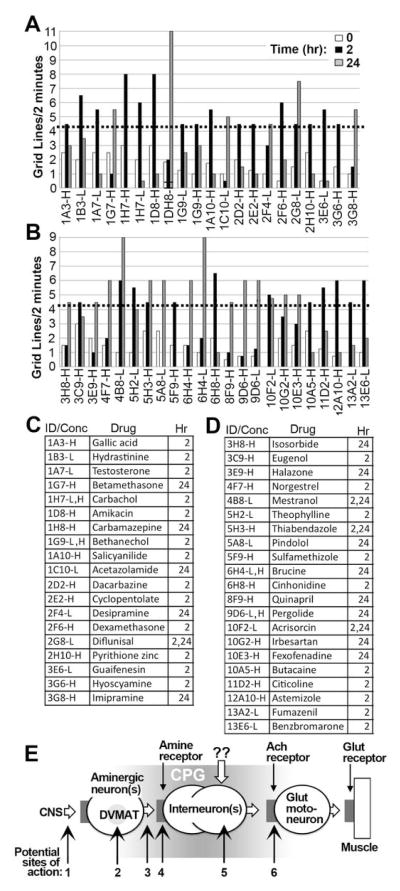Figure 2. Primary screen hits.
(A–D) Shown are the 40 of 1039 tested drugs that increased locomotion >3.5 SD above the mean (>4.2 grid lines per 2 min, see dotted line) at either 2 or 24 hr and either the low (L, 10 uM) or high (H, 100uM) concentrations, labeled with the ID number from the Microsource library used for the primary screen. The drugs shown in panels A, B are listed (Table C, D) by their library ID number and their effective concentration (High or Low as in A, B, shown as ID–H or –L in the first column of C and D). The assay times (2 or 24 hrs after administration, or both times) at which the drug yielded a positive locomotor response is listed in the right hand column of C and D. (E) Model of larval locomotor circuit. The larval locomotor circuit remains incompletely defined; we show here a heuristic model of the minimal elements known to be present in the locomotor circuit as an aid for interpretating the results of the screen. Minimal elements of the circuit include (from right to left) the muscle expressing glutamate receptors (Glut receptor) innervated by a glutamatergic motoneuron (Glut motoneuron). Larval motoneurons express Ach receptors that stimulate their activity; they are therefore presumed to be innervated by a cholinergic interneuron but the identity and number of interneurons(s) is not known. Amines including octopamine and under some conditions dopamine are released onto yet to be identified cells (labeled “Interneurons”) to activate the central pattern generator (“CPG”) and thus stimulate locomotion. The cells included in the larval locomotor CPG are not yet clearly defined and the shading of the CPG reflects this ambiguity. It is possible that there are additional non-aminergic inputs to the CPG capable of activating locomotion; these are indicated by “??”. Numbered arrows indicate possible sites of action for drugs including 1) upstream sits in the CNS that activate the aminergic neurons, 2) DVMAT and/or proteins that regulate vesicular storage in the aminergic neurons, 3) the exocytotic release machinery of the aminergic neurons, 4) amine receptors including OA receptors for a activation of baseline locomotion, 5) alternative amine-independent inputs (indicated by “??”), 6) Ach receptors. Targets 1–3 would require presynaptic amine storage and are DVMAT dependent (see text). Targets 4–6 would function independently of DVMAT and presynaptic amine storage.

